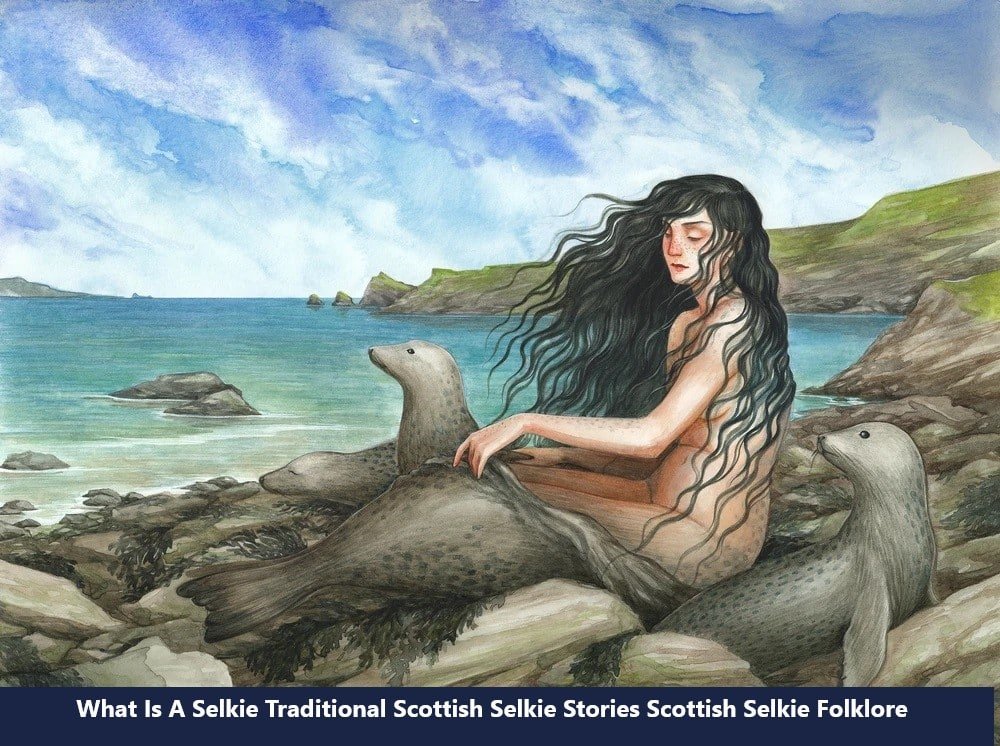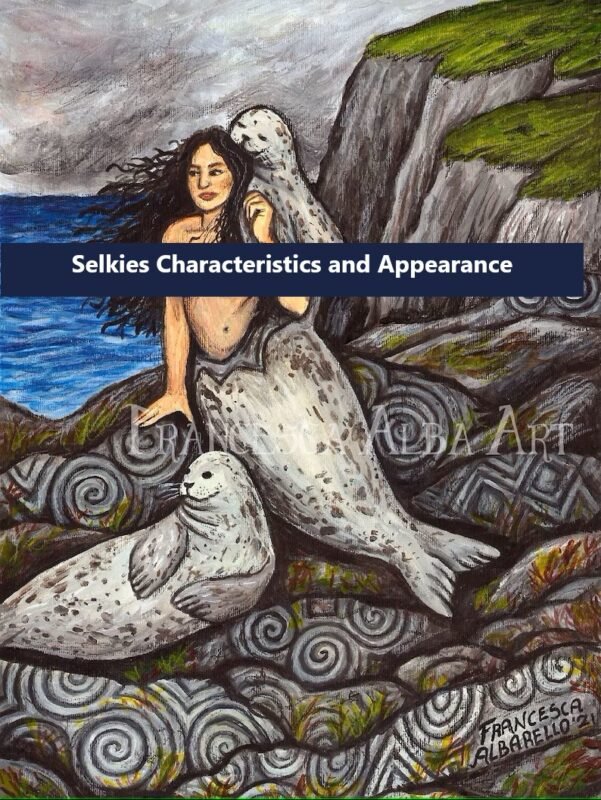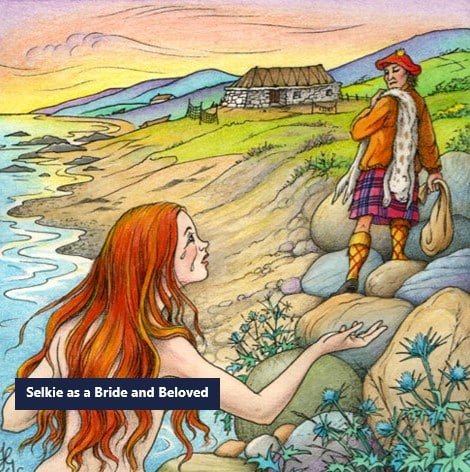What Is A Selkie? Traditional Scottish Selkie Stories

Have you ever pondered the nature of these magical beings that twirl between legend and the ocean? Allow me to acquaint you with the intriguing realm of selkies. The Selkie, what is it? Envision beings with the ability to metamorphose from seals into humans. This has enchanted coastal towns for generations. Celtic and Nordic mythology provide the magical beings that inhabit these tales of love, loss, and the boundless ocean. Investigate the Selkie with me. Be captivated by the legends surrounding these magical creatures that can change shape and the waters they inhabit.
The Selkie, what is it? Overview and Background
The magical Selkies appear in Celtic mythology’s human and aquatic realms. Celtic folklore is the source of the word “selkie,” which means seal in Gaelic and is spoken in Scotland and Ireland. The mythical ability of seals to shed their skin and reveal a humanoid figure beneath represents the mystical bond between the sea and the land. These fantastical beings lend an aura of intrigue to seaside communities and are intricately woven into the rich fabric of maritime folklore.
Characteristics and Appearance
A selkie’s dual nature as a beautiful human and a sleek seal has earned them widespread renown. Seals can gracefully traverse the ocean floor thanks to their shiny fur and expressive eyes. When selkies assume their human form, they exude an otherworldly allure that is frequently compared to being ethereal or enchanting.
According to folklore, they are wistful creatures who miss the depths and complexity of the ocean. Their mesmerizing transformations between the two forms have left an indelible impression on the stories told in coastal towns.

The Selkie: Mentioning Irish or Scottish Folklore
Selkie mythology draws from diverse sources, including the rich cultural traditions of Ireland, Scotland, and others. Legends of selkies were passed down through the ages in these Celtic realms.
The Scottish Gaelic word “selch” is an etymological ancestor of the English word “selkie,” meaning “seal” in modern English. As fanciful beings, they represent the sea’s mystical connection to the human realm. People who live along the rough coastlines find them fascinating.
Myths and Stories about Selkies
The sea’s magical, romantic, and mystical elements come together in captivating ways in selkie tales. The ability of selkies to transform between human and seal forms is a common element in selkie legends.
The finding of the magical garment that grants the power of change—the sealskin of a selkie—is one of the most common themes. There are many stories in folklore about selkies’ love and separation and about what happens when you mess with a sealskin.
The stories passed down through the years never fail to enthrall those who hear them. They create a magical world where the ocean and human feelings are intertwined.
A Selkie’s Transformation
The capacity of the legendary selkies to change bodies between humans and seals is central to selkie mythology. Envision a calm ocean where a selkie elegantly transforms from a beautiful seal into an enchanting human. Here, we see the miraculous bridge that links the sea and the land.
When a sealskin is worn or shed, it often sets off this transformation. It enhances the enchantment and mystique of Selkie tales.

Seals and Human Form
The Selkie is renowned for its bimorphism, which allows it to inhabit both the deep sea as a seal and the high seas as a human.
During the metamorphosis, the lines between the watery and landy worlds become more porous, as if in a mystical, ethereal ballet. A lasting impression on coastal folklore is the Selkie’s capacity to switch between the two forms, whether walking on the beach or gliding over the waves.
What Seal Skins Are and Why They Matter in Selkie Tales
The ownership of sealskin is deeply symbolic in numerous selkie tales. Transforming between a seal and a human is possible with the help of the sealskin.
The vulnerable but enchanting Selkie enters the human realm when it sheds its sealskin. A selkie would maintain its human form if a human were to steal its skin and keep it hidden. This exemplifies the precarious equilibrium between the enchantment and earthly connections people share.
In selkie mythology, sealskin represents independence, fate, and the interplay between the fantastic and the everyday.
Selkies Symbols
Symbols that go beyond myth form folklore’s rich tapestry. They shed light on the human condition through the recurring themes in their stories. Love, freedom, and the eternal bond between humans and the natural world are all explored in these works. Allegories like these fantastical creatures encourage us to think about questions of self-discovery, metamorphosis, and the ever-changing interplay of the elements.
Theme of Selkie Stories
All cultures find common ground in the timeless themes found in selkie tales. While selkies deal with the tug-of-war between their earthly connections and the allure of the sea, themes of love and loss emerge.
The transformative power of the sealskin investigates autonomy and its repercussions. Both are captivated by the narrative tapestry that develops around the themes of secrecy and longing, which incorporate the inevitable clash between the mundane and the mystical.
Cultural Importance and Interpretations
Diverse cultural backgrounds in the Selkies’ home regions give rise to diverse interpretations of their stories. They stand in for nature’s wild, unruly elements in certain tales. Some represent the importance of having familiar and mysterious elements in a story.
The cultural importance of selkies extends far beyond their role in entertainment. Through them, communities can better understand their connection to the ocean, their place in the world, and the impermanence of human existence. The Selkie represents the human experience metaphorically. They bring us in touch with the timeless folklore that links us to the enigmas of nature and encourages us to delve into our feelings.

The Cultural Role of Selkies
The ethereal allure of the Selkie has deftly made its way from old folklore to modern popular culture, making an indelible impression on both books and movies. Their stories of magic and metamorphosis have enriched narrative landscapes, and audiences have been captivated by these fantastic creatures.
Selkies Character in Literature and Movies
Selkies have inspired innumerable works of fiction and films. Their otherworldly appearance makes tales seem more enchanted. Novels and stories incorporating selkie themes delve into complex themes like love, identity, and the boundary between the supernatural and the natural world. Selkies have also enchanted Hollywood. The fascinating tales of these legendary beasts have been brought to life on screen, enthralling viewers worldwide.
Updates, Impacts, and Recent Developments
Even in the present day, selkies hold a certain allure and imaginative people are always finding new ways to spin the tales. Modern novels delve into the tangled web of selkie legends, shedding light on these ancient tales in fresh ways.
Selkies are still blowing people away in movies. They captivate audiences through both conventional and unconventional means. Their impact on popular culture evidences the Selkie’s enduring allure. The enduring fascination with these mystical beings guarantees their enduring popularity and adoration.

Influences in Real-World
Although selkies are more commonly linked with myth and legend, they have practical effects, particularly concerning marine ecology and cultural practices. Subtle environmental allusions abound in selkie tales, mirroring the interdependence of coastal populations and the ocean.
Relevance to Sea-Level Management
Inspiring coastal residents to connect with marine ecology, selkies are mythical beings that bridge the sea and the land. Observing seals in their natural habitat is a wonderful opportunity to learn about their deep connection to the water. The coastal origins of selkie mythology allow it to mirror the tides of aquatic environments. The interplay between the underwater and terrestrial realms is highlighted.
Influence on local traditions and beliefs
Communities along the coast have long-held traditions that include selkies. Those who dwell by the sea weave these fantastical beings’ tales of love and yearning into their own. Tales of selkies frequently shape superstitions and local practices. They influence how the community views and engages with the natural world. Selkies impact coastal cultures that extend beyond folklore and into everyday practices and beliefs.

Conclusion
To sum up, a selkie is a legendary beast with strong roots in Celtic mythology, particularly in the folklore of Ireland and Scotland. A selkie is a fantastical beast that can easily switch between human and graceful seal forms. The magical connection between the human and marine realms is central to the Selkie’s identity. To what extent is Selkie defined? Presents many narratives that delve into love, grief, and the fine line between the natural and supernatural realms. From seals plunging through the ocean to humans strolling along shores, selkies captivate coastal communities with their timeless magic.
Frequently Asked Questions (FAQs)
Are Selkies good or bad?
The typical portrayal of a selkie is neutral. The stories in which they participate greatly impact their character. Some stories have selkies as charming, helpful beings, while others show how their relationships with humans can bring joy and sorrow. Various folklores paint a diverse picture of selkies, revealing their complex nature.
How are selkies and sirens different?
Among the legendary sea creatures are both selkies and sirens. Their traits are distinct. The sirens of Greek mythology are beautiful but deadly creatures that entice unsuspecting sailors with their enchanting voices. Seals with human-like abilities are known as selkies. Celtic mythology is where they originate. Typical themes in selkie tales include love, metamorphosis, and the precarious equilibrium between the marine and human realms.
What is a Selkie in Scotland?
The mythical Selkie symbolizes the mystical bond between land and sea in Scottish folklore. Celtic mythology is where the Selkie first appeared. It is frequently depicted as a seal that can shed its skin and expose a human form. On the Scottish coasts, these fantastical creatures play a central role in tales of love, loss, and the interplay between humans and nature.
Can a human be a selkie or vice versa?
Being turned into a seal is uncommon in traditional Selkie mythology. The traditional Selkie was a seal that could shed its skin and become a human. How a human’s story intersects with selkie mythology can take many forms, depending on the author’s intentions.
Why are kelpies feared by Scottish Folklore and tradition?
Due to their evil reputation and close association with water, kelpies are terrifying in Scots folklore. These fantastical beings have been portrayed as ethereal horses that can transform into water spirits. According to urban legend, kelpies will entice naive riders—especially kids—to get on top of them before dragging them down into the water to drown. People have had an inherent fear of kelpies for generations. Stories passed down through the generations in Scotland often center on the perils of water.

